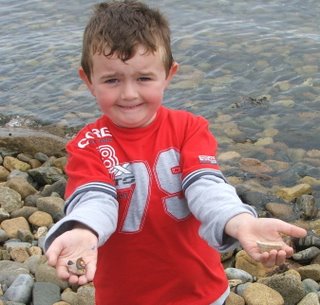 Eyre Square, Christmas 2006
Eyre Square, Christmas 2006What looks like snow around the base of the 'Galway Hooker' fountain sculpture is actually the result of someone putting washing up liquid into the water! Sadly, we had no snow this December or any December for the last few years, one more obvious sign of the warming up of the world's climate.
Treasure Chest, Williamsgate Street

One of the more attractive shop fronts that actually took time and effort to decorate for Christmas.
The Treasure Chest is an up-market gift shop owned by Mary Bennett who pioneered in Galway city the development of a retail outlet orientated towards the tourism market.
Gone though is the nearby Taafes family boutique whose owner, Una Taafe, died earlier this year. The shop is now boarded up and was recently bought by business man Gerry Barrett who seems to buying up half of the city's retail and hotel trade (He also bought the landmark 'Bow Street Magistrate's Court' in London during earlier this year). Una was certainly a strange and intriguing character. She seemed to possess some of the elements of the old lady in 'Great Expectations' about her. Once a society dame she lived in a premises that boosted a fine tennis court and a ballroom that once attracted the 'hoi-polloi'. Yet, for years, she would appear outside the shop dressed in hideous decrepit cloths and garish make-up, sit on a stool and sell the many puppies that inhabited her premises. Though she appeared as poor as a church mouse, Una had 8million euro in her bank accounts when she died.
The boutique itself boasted some of the finest traditional Irish-woven woolen clothing. But the place reeked of dog's urine. Though avoided by Galwegians, the shop proved highly popular with tourists!
 Busking on Shop Street
Busking on Shop StreetA popular sight outside Easons store is this busker with his musical puppet machine.
Though not Irish, he tends to play Celtic tunes. Though I don't know his name, he is always smiling and courteous to the passing pedestrians. For the festive season, he set up a life sixe Santa and donned a red hat!
Buskers ahve been a familiar sight on Shop Street since the late nineteenth seventies. Though not welcomed initally by the shop-owners, busking is now part of the street's fabric.
Of course, it has to be said that the quality of the performers varies enormously!
Charlie Byrne's Bookshop, Middle Street

Charlie's bookshop was packed with local and tourist customers over the Christmas period.
At this stage, it is a Galway institution and is probably the most famous secondhand bookshop in Ireland with rooms of wall-to-wall shelves crammed with every topic under the sun.
Many of us spend hours browsing through its vast but well-labelled collection.
Charlie himself can be seen on the right of the photograph. He is very likeable fellow of a quiet disposition. An old friend of mine, Charlie and myself shared a house together when we were students at NUI Galway that was well known for its all-night parties and shenanigans! 'Nuff said!
Taafe's Bar, Shop Street

Taafe's Bar was pleasantly decked out.
Notice the cordoned off seating area to the left- this is one of the pleasant side effects of the government's 'smoking ban' introduced into bars, hotels and restaurants a few years ago.
The 'Irish Pub' was typically an 'inside' venue. Now most bards have introduced beer gardens and outdoor seating areas giving Irish streets a 'continental' flavour.
St. Patrick's Brass Band, outside 'Brown Thomas' store
 Fund-raising for one of the most popular bands in Galway on Christmas Eve.
Fund-raising for one of the most popular bands in Galway on Christmas Eve.Brass bands were once a common sight in Irish towns and cities. Traditionally associated with trade unions and factories from the 19th century onwards, there are now sadly few of these musical outfits left. But I have a soft spot for the sound of a trumpet.
Williamgate & Shop Streets on Christmas Eve
 The large modern shopping centres in the suburbs may have captured a large segment of the city's shoppers. But Galway's city centre with its narrow streets and innumerable little boutiques, music stores , restaurants and bars has lost none of its traditional sparkle.
The large modern shopping centres in the suburbs may have captured a large segment of the city's shoppers. But Galway's city centre with its narrow streets and innumerable little boutiques, music stores , restaurants and bars has lost none of its traditional sparkle.









































